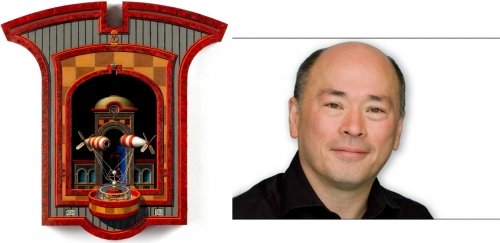Art New England Editor to Hold Public Interview With Artist of Curiosities Richard Whitten
- News & Events
- News
- Art New England Editor to Hold Public Interview With Artist of Curiosities Richard Whitten

At left: “Augenblick” (Blink of an Eye), oil on wood panel, by Richard Whitten (right).
The latest creations from the inventive and imaginative mind of Associate Professor of Art Richard Whitten are on display at RIC’s Bannister Gallery in a show titled “Wunderkabinett: A Cabinet of Curiosities,” running through April 19.
On Thursday, April 17, at 5:30 p.m., Editor-in-Chief of Art New England and Independent Curator Judith Tolnick Champa will host a public interview with Whitten inside the gallery where the two will discuss his work, surrounded by his paintings, drawings, models, antique toys, mechanical devices and scientific instruments.
In a catalogue essay, Champa wrote: “The overall feeling one leaves his exhibitions with is that of being led on a trip, beautiful but tinged with mystery, by a true master who’s having as much fun as we are.” She said, “I am greatly looking forward to exploring his many interests and process in an interview with him.”
Whitten not only has a fascination with dated toys, he also delights in toying with perception. Viewers of his paintings are met with a rich multicolored palette reminiscent of a court jester's vestments. Within the paintings are mechanical toys with gears, wheels and pulleys set against Romanesque or Renaissance architecture. Through Whitten’s masterful use of trompe l’oeil or “fooling the eye,” viewers are forced to look upon the dream-like scene through portals or framed entrances, yet they are never permitted completely inside but are left to imagine what lurks beyond view. The toys point to a forgotten childhood. They appear frozen in time, frozen in mid-motion. And neither past nor present, real time or dream time, this world or some unknown world, is certain in the mind of the viewer.
In his artist statement, Whitten writes:
“My paintings are about play. My paintings are, in some ways, very serious toys. This does not mean, however, that they are frivolous. Play is a very serious activity – an impetus for learning and exploration. Neither is play nor my paintings all about fun. These paintings imply the existence of other places – “invisible cities” – that can be visualized, but, like the garden in Alice in Wonderland, can only be desired – not reached.
“As I design these spaces, I answer simple demands: to look down, to look around a corner, to look around a curve. The imagined architecture is designed to make the viewer look in a specific direction; to feel curious about what is partially hidden; to feel exhilarated by a vast expanse. As the images develop, they also take on references to the past: intimate niches, the vast vistas of the Renaissance painters, or the dramatically lit Baroque spaces of Piranesi – spaces that have a sense of history and place and meaning.”
Whitten’s exhibit also extends beyond the gallery. In glass cases directly outside Bannister Gallery, he displays his personal collection of antique toys, many of which are more than 100 years old. The animal sculptures have washed-out finishes and tarnished metal. There is an automated bobbin winder and toy locomobiles (trains on wheels). In another display case, he reveals the preliminary drawings that led to his finished paintings. And within the gallery, he exhibits 3-D models of mechanical objects that he built himself and which eventually make their way into his paintings.
Champa said she looks forward to getting at the heart of this illusionist and his Wunderkabinett of curiosities.
Bannister Gallery hours are Tuesdays through Fridays, noon to 8 p.m. or by appointment with the gallery director.
